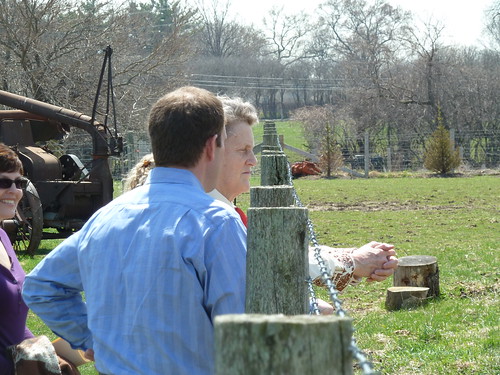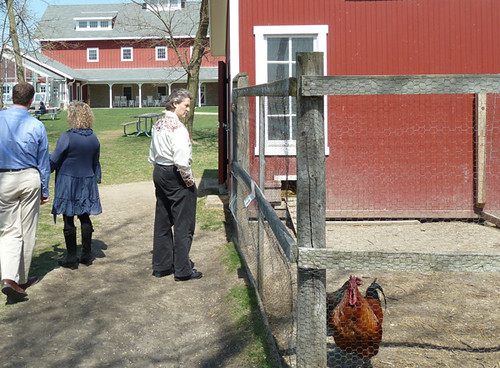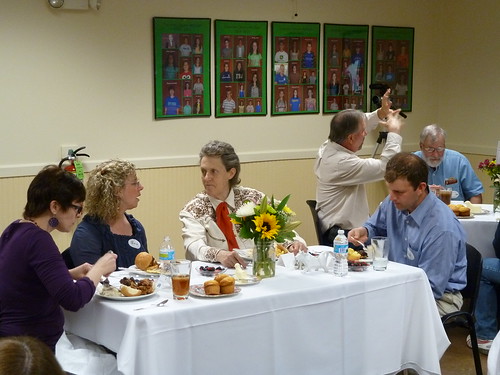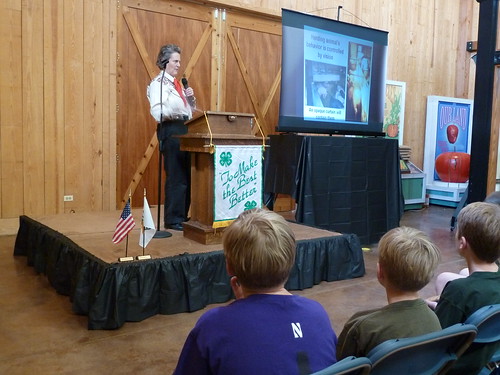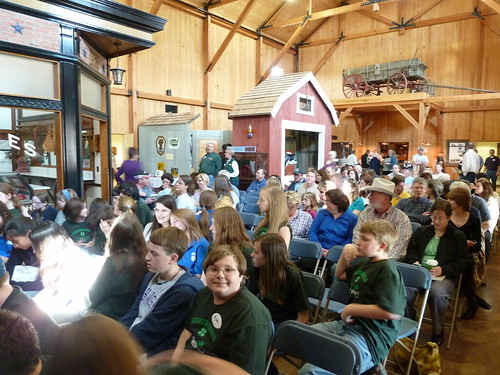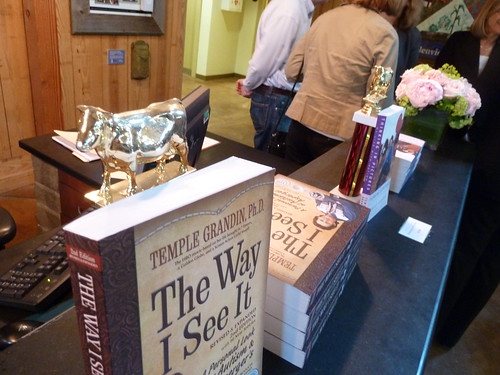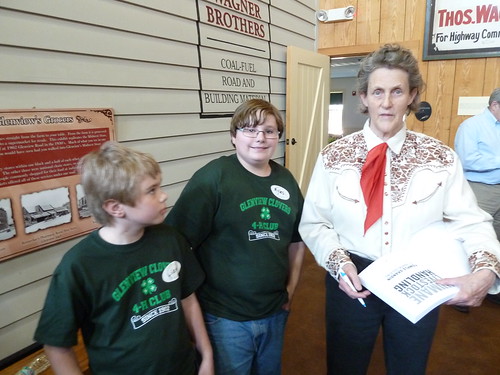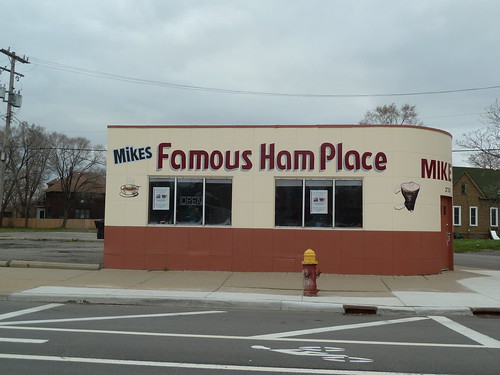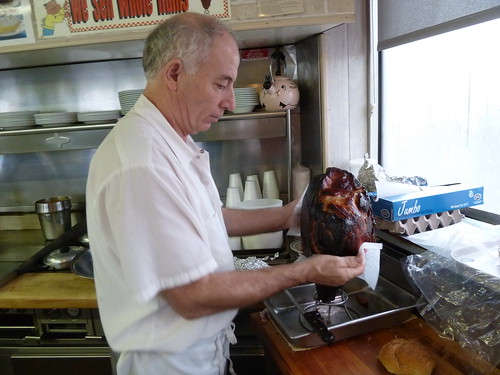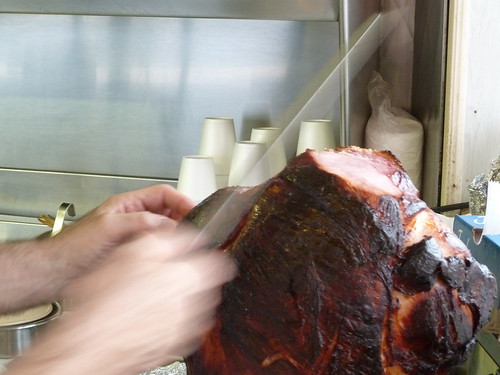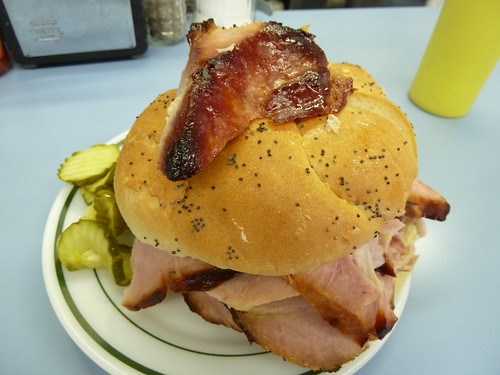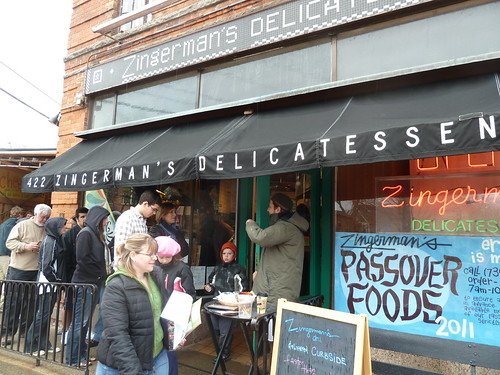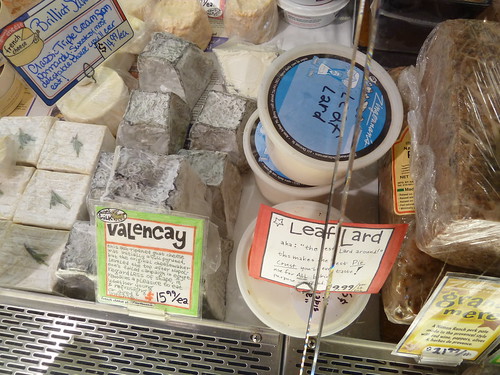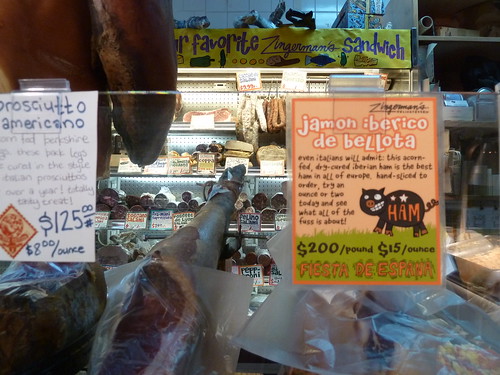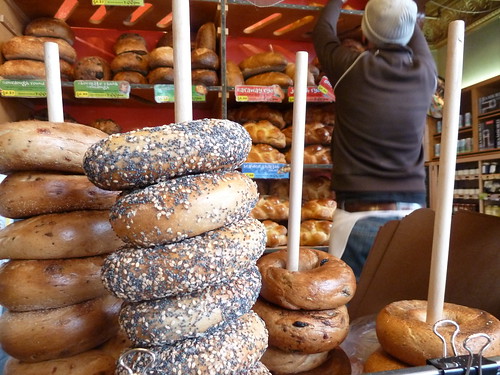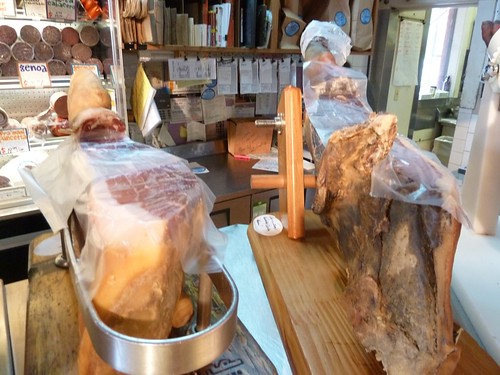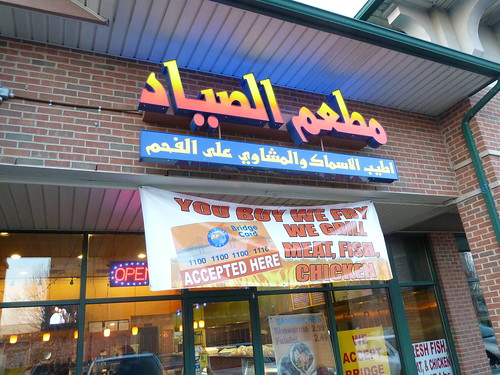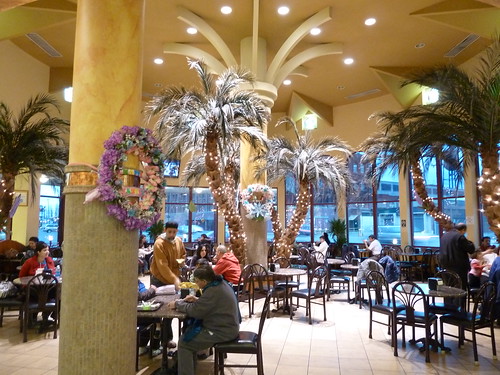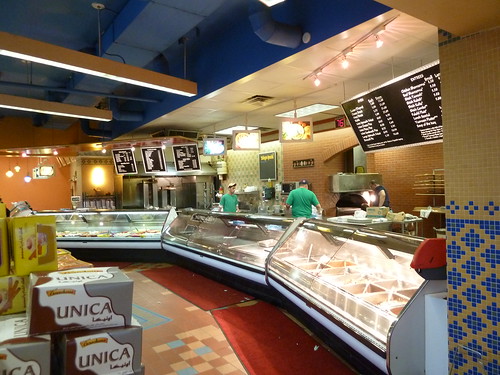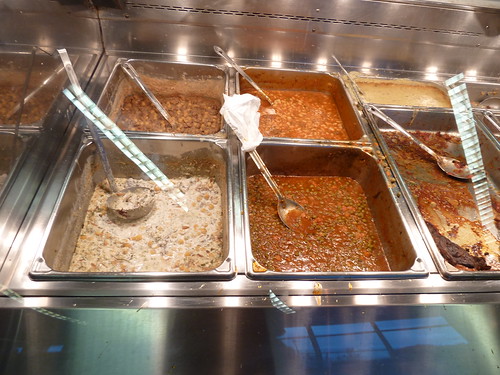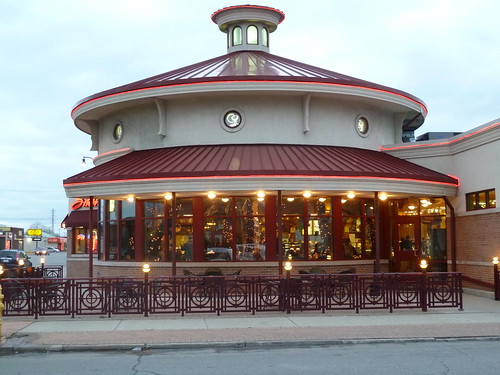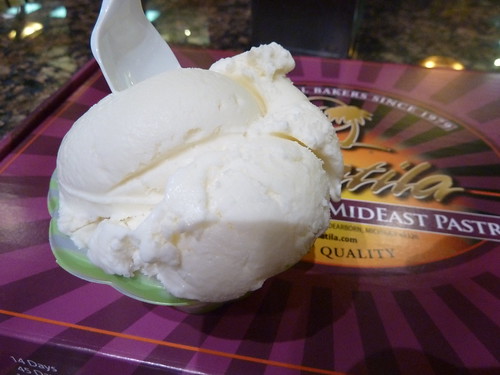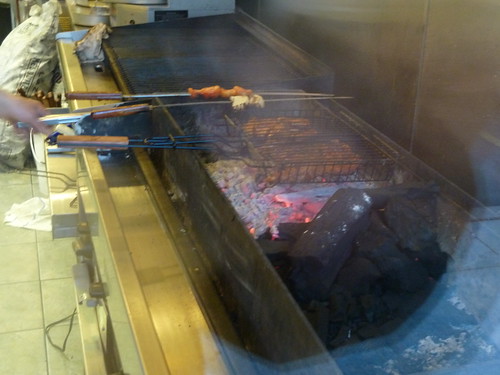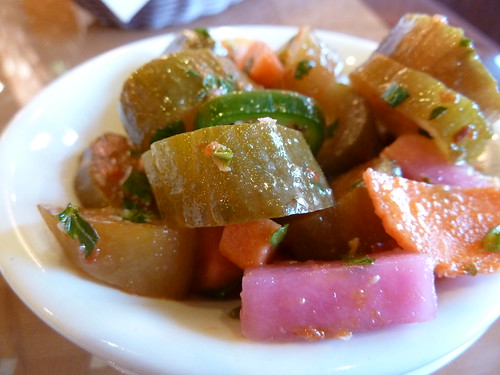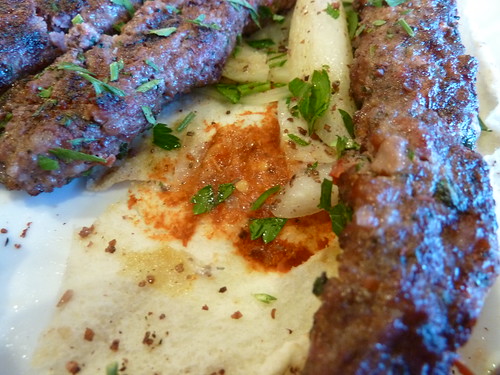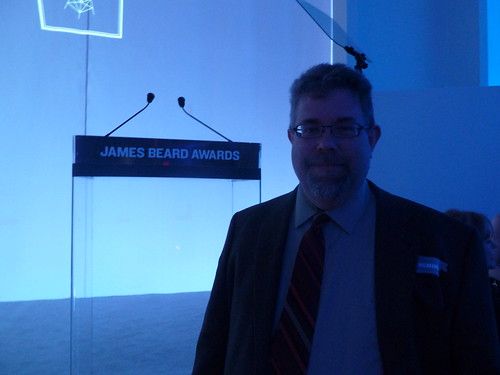
As close to the podium as I thought I was going to get.
Having been nominated in the “Multimedia Feature” category for the James Beard Foundation Awards, I went to New York with a firm conviction that I was not going to win. (And by “I,” I mean “we,” my fellow nominee Julia Thiel who writes Key Ingredient in the Chicago Reader and myself.) Partly this was a defense mechanism— if I actually thought we would win, I’d be nervous; being convinced we would not, I was nonchalant, kind of. But part of it was that I really thought Andrew Zimmern would win, being famous, or Katherine Shilcutt, the lady from the estimable food section of the Houston Chronicle, whose editor is Robb Walsh, famous in his own right for a barbecue book I clutched throughout several trips to Austin. Illustrious company to be nominated in, who the heck are we to really compete with them?
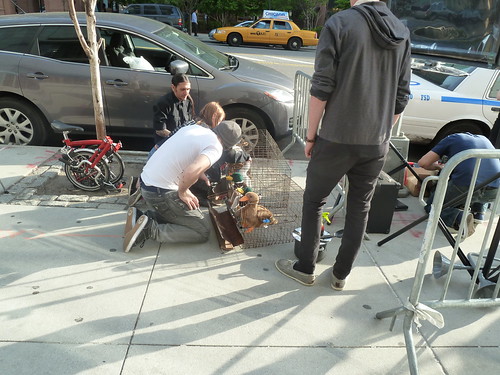
Anyway, so Friday evening comes, my family who traveled with me to New York is off to see a play and I stroll over to the event space in Hell’s Kitchen… and the first thing I see is that animal rights protesters have set up stuffed animals in cages to protest the cruelty of fine dining. I notice that they also have what looks like a spray bottle of fake blood— if you’re going to spray that, I think, it’s going to be on the dress clothes of someone better paid than me.
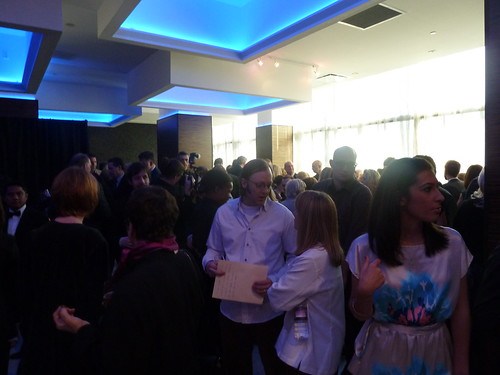
I check in and get a little badge which says Nominee, which serves as a great icebreaker— throughout, people come up to me, or I to them, and say, so what are you nominated for? I catch the eye of the distinguishedly sturdy fellow on the right with salt and pepper goatee and he introduces himself.

“Robb Walsh,” he says, thrusting a hand at me. I can only repeat, dorkily, “Robb Walsh!” In an instant I realize that the whole evening is going to be like this, meeting people whose names I know, but whose faces are professionally hidden most of the time. It’s an odd social situation, but I make the best of it I can, and I think this is my awkwardness low point, which he handles graciously, wishing me luck even as he acknowledges that he’ll have a grieving reporter on his hands if Katherine Shilcutt loses to us. (Besides being Shilcutt’s editor, Walsh is nominated with two others for a story on oysters which appeared in, of all things, Garden & Gun, whatever that is.)
I’m a little suaver when I spot and zero in on Andrew Zimmern, who has a crowd around him, as most of the recognizable TV celebrities here do. I push my hand forward and say, “Since I’m going to lose to you in about 90 minutes, I figured I should say hi.” That disarms him and we talk for a few minutes about his recent Chicago episode. He manages to combine down to earthness with a celebrity glow and high voltage persona that makes you instantly understand why someone thought he’d be a natural for TV.

We take our seats— Julia, myself, and Mara Shalhoup, the Reader’s new editor, right up front (though my best view of the event will be the projected image on a side wall). More celebrity glow is on hand when Ted Allen and Gail Simmons take the stage; on Top Chef, Gail may play the more approachable Mary Ann to Padma’s exotic fashionista-dominatrix Ginger, but she’s quite glamorous in real life, and that wasn’t a faraway observation since she sat at our table when she wasn’t needed on stage.
The chair of the awards committee comes out and explains the changes in the awards this year, which have greatly expanded the number of categories to reflect the much more varied and, importantly, online basis of the profession of food writing these days. This doesn’t actually affect our category, which has existed for a while (Mike Sula and I were nominated in it two years ago), and I’m sure Beard cynics like Anthony Bourdain would say it’s just to increase the number of people sending in their entry fees, but compared to the way many journalism awards are still hopelessly hidebound (the Pulitzers just gave their first prize for reporting to a purely online story, which to my mind is sort of like giving the first Oscar to a talkie in 1940), it seems to me progressive and smart. Likewise, where the Beards could be awards from New York publishing for New York publishing, the regional sweep of the awards, taking in everywhere from Minneapolis to Seattle, is admirable.
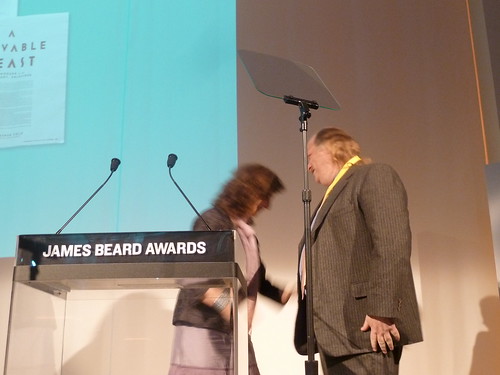
Many, many awards follow— nerve-wrackingly, ours doesn’t come till after the second course— but some particular hero-worship highlights for me included Jonathan Gold winning the M.F.K. Fisher award for distinguished writing. Gold was chronicling grungy taquerias in L.A. before Chowhound was a gleam in Jim Leff’s eye, he’s right up there with Calvin Trillin as far as I’m concerned for the guys who first turned attention from haute to hot-n-greasy cuisine.
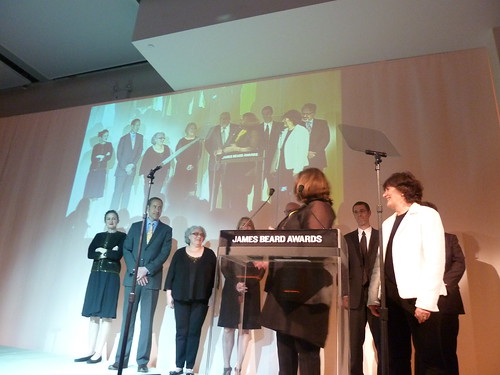
The Edible Communities group of publications won a special award for pioneering their model of hyperlocal coverage.

While Wylie Dufresne gave a thoughtful appreciation of a book that has had enormous influence on his generation of molecular gastronomists: Harold McGee’s On Food and Cooking. McGee in turn said that he hears all the time from young chefs in culinary school who can’t find out what they want to know from their traditionally-trained teachers, so they go direct to the source— him.
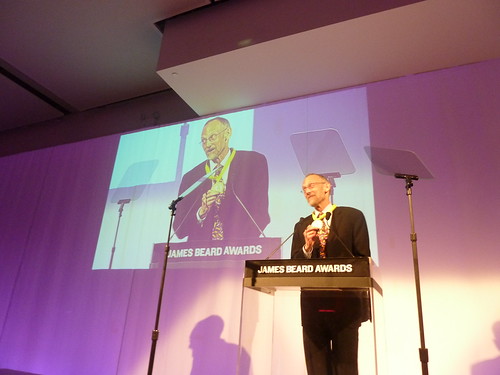
Somewhere in there our batch of awards comes up. At some point Julia and I realize there is actually a nonzero chance that we might wind up on stage— we don’t know what to make of the fact that we seem to have been seated quite close to it, for no good reason we can see— and we talk about what we might say if we do. It’ll be short, we agree on that much. Ted announces our category and I start recording video as the computer system slightly botches a clip from our very first Key Ingredient, starring Grant Achatz:
The moment I hear “Mi—” I mutter “oh my god” and flip the camera off. Julia and I look at each other with a bit of shock and she leads the way. There are, thankfully, two medals for us (they got that right in the multimedia category), and Ted Allen, who used to be at the Tribune, warmly says “Welcome, fellow Chicagoans” as he puts them around our necks.
Julia takes the microphone and offers both thanks and a memory of the late Cliff Doerksen, who won a Beard award last year and died a few months later. I’m not expecting this but it’s absolutely the right thing for her to do and she does it beautifully. There’s not a lot more for me to say, so I just make a quip to the effect of “Thank you for supporting regional work from small obscure places like Chicago,” which gets a mood-lightening laugh (but does represent my genuine appreciation that the Beards look beyond New York for great work), and we exit to go have our portraits taken in front of the obligatory wall of logos.
We return to our seats, but two or three times later we will turn to each other and say some variation on the theme of, “Holy shit, we won a Beard award.”

And the awards continue. Ruth Bourdain wins the first one to go to a Twitter account, or to a nonexistent person, leading everyone to immediately start murmuring— will we finally see who Ruth Bourdain is? No such luck, a Beard committee member accepts it (though since it was nominated, it does mean that the person behind it broke character long enough to actually enter it him/herself). Another hero of mine, Southern food writer James Villas, wins for his fine cookbook Pig and says one of the night’s most memorable soundbites: “To quote Dorothy Parker when she received an award late in life, it’s about goddamn time.” The applause indicates general agreement with the sentiment.
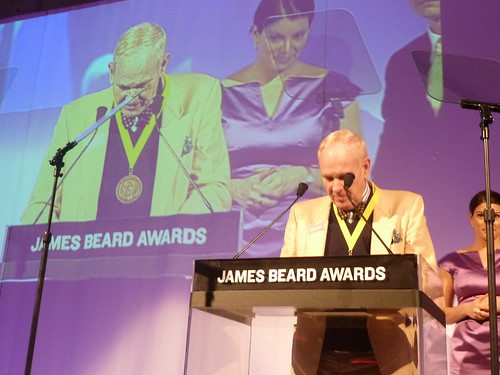
Grace Young, author of Stir-Frying to the Sky’s Edge, gives maybe the night’s best speech. As she explained, before her book of family Chinese recipes and lore was published, her father (its inspiration) died, her editor left after 20 years, her agent quit the business, her publicist quit… but she stuck to it and had her reward, in what struck many as a surprise win over Diana Kennedy. (If they put the full video up, you should definitely watch her speech, and Dufresne and Harold McGee.)
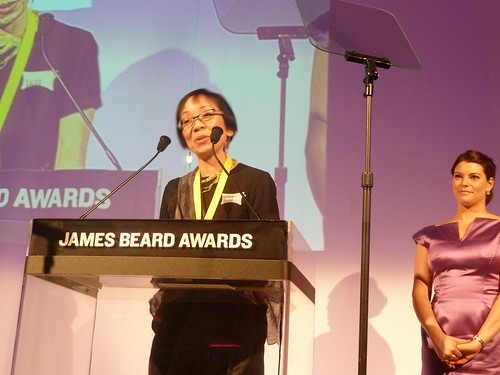
A few minutes later, part of the reason for the surprise win over Diana Kennedy was revealed— the committee had decided to create an award honoring one cookbook as best of the year, clearly (given the way it was presented) with an eye toward giving a boost to important, but not entirely commercial, projects. And the inaugural winner was Kennedy’s Oaxaca al Gusto: An Infinite Gastronomy, which even after her pioneering role in all the Baylessian Mexican food that has followed, couldn’t find a commercial publisher and was ultimately put out by the University of Texas.
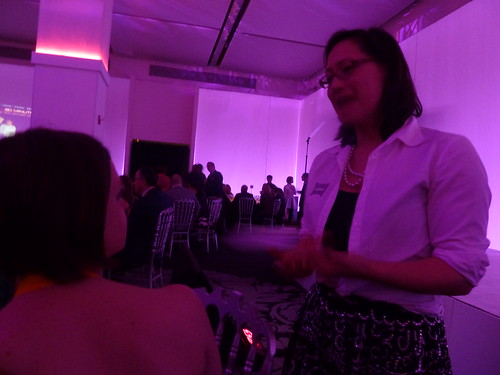
And so the awards wrap up. Monica Eng, the only other Chicago journalism nominee this year (who totally should have won last year for her series about going to see slaughter), comes by and congratulates us. Julia calls her the Mindy Segal of journalism, in reference to the great Hot Chocolate pastry chef’s perennial also-ran status, but I prefer to think of her as being our Deborah Kerr, eight Oscar nominations, no wins, but always a class act.
Emboldened by the big piece o’ bling hanging around my neck, I decide to go say hi to a couple more of my heroes. Villas is nowhere to be seen, alas, but I do find Jonathan Gold and introduce myself. Looking at my Sky Full of Bacon business card, he says “Oh, I know this blog. I like this blog,” and immediately we go into a discussion of Alinea, where he just ate… and how he wished he’d been off sampling Chicago’s Mexican or Indian food at several points during it. (Let’s just say that he thinks that there’s no injustice in Noma being several rungs above Alinea on the San Pellegrino list.) When I make a witty observation about Alinea from one of my shoots, he says “Oh, I’m so stealing that,” which I can only beam at.
That in turn leads to a discussion of the food scene in Chicago. “Chicago has a great food community, there’s that, what is it, HRM Forum or whatever,” he says. “There’s nothing like that anywhere else.” But the rise of amateur online foodies has made his job harder: “There are so many people who have it in for me now, who’ve drilled so deep into something like Thai food or ramen and they go around saying I don’t know anything.” He just kind of shrugs amusedly at this— after all, he won the M.F.K. Fisher Distinguished Writing award, not just the Distinguished Discovery of Strip-Mall Carnitas award— but of course I know exactly who the Thai food reference is in regards to. “You mean like Erik M.?” He smiles and nods and asks me about him.
As we’re talking Andrew Zimmern comes over and congratulates me very graciously; he goes home 0-for-2 tonight (though he won last year). And that’s sort of the perfect moment that encapsulates this great journey from early days posting at Chowhound and then helping start LTHForum to this night— Andrew Zimmern congratulating me while I talk with Jonathan Gold about Erik M.
Thanks to the Reader for this great opportunity which I hope did them proud, thanks to Julia, my partner in chef-torment, and thanks to you, dear readers, some of whom I’ve known online or in person since those very first days to now.
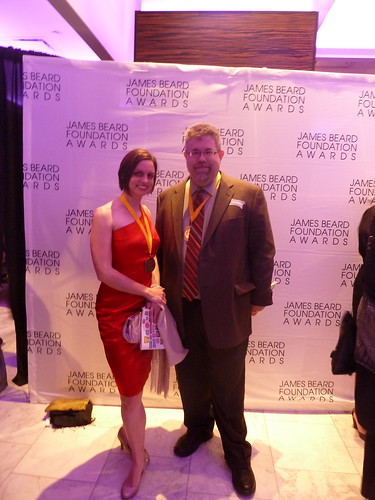
More: Chicago Reader Chicago Tribune Eater Grub Street The Feast Crain’s


 Posted in
Posted in 

